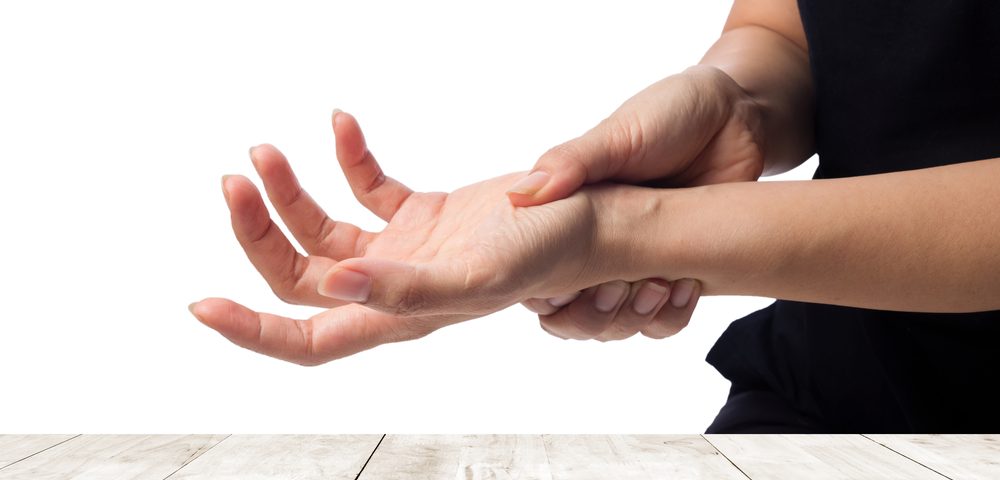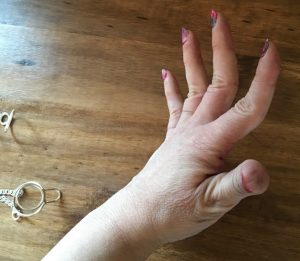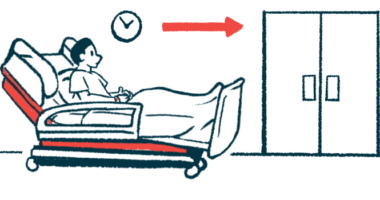Getting a Handle on Hand Pain and Reduced Function Due to EDS

Pain and the reduced function of my hands significantly affect my life. Knowing what components are structurally compromised and vulnerable to injury due to Ehlers-Danlos syndrome (EDS) aids me in the prevention and treatment of my injuries.
Puppets
Have you ever seen a toy grabber hand? It is a mechanical “hand” made of segmented fingers connected by cords that run through a handle to a squeeze-bar mechanism. Squeezing the bar pulls the cords, causing the fingers to curl. Sophisticated versions have separate triggers for each finger.
Human fingers operate in a similar way. Fingers have no skeletal muscles — they are controlled by tendons attached to muscles located in the hand and wrist. Ligaments connect the bones of the finger segments, running over each knuckle and keeping the tendons in place. As the muscles in the hand and wrist contract and relax, the tendons are pulled, resulting in movement of the bone segments, like how the toy fingers are controlled by the cords attached to the squeeze bar.
Again and again, now and later
EDS affects the structure of tendons and ligaments. Much of my hand pain is due to strain. It does not take many repetitions for me to get repetitive strain injury. De Quervain’s tenosynovitis, carpal tunnel syndrome, paresthesia of my hands, and lateral epicondylitis (tennis elbow) are not uncommon conditions. But to have them without any trophies as a consolation seems a bit unfair. While EDS makes for an interesting explanation, I would much rather have had the life experiences that typically accompany repetitive strain.
My tendons and ligaments overstretch, causing the tendons to slip out of their natural grooved positions, which can lead to my bones moving out of place.
Bones with too much freedom are like rowdy dogs on long leashes: One minute they appear to be under control, the next they’re running for each other, and the leashes are too long to stop them before they make contact.
Pain from dislocations and subluxations (partial dislocations) is a cue to stop whatever activity has caused it to avoid injury or further damage. Unfortunately for me, my body often opts for the “pain deferment program” — a “no pain now, but you will pay later, plus interest” type of arrangement. Initially, bone-to-bone contact affects the soft tissue located at the end of the bone. Once that is worn away, the bones damage each other and can cause osteoarthritis.
I won’t allow the problems that ended my glassworking career to claim the remainder of my abilities — I have a plan.

Hypermobile fingers can eventually lock into odd positions. Did your mother ever tell you to stop making a silly face or it might stay that way? I tell myself and my children the same thing, but about our fingers! Here we see the hypermobility of my proximal interphalangeal joints, or PIP joints. (Photo by Kimberly Stark Horn)
Keeping superpowers in check
My fingers can bend backward on command and sometimes drift into awkward looking positions on their own. When I was a young person, moving my fingers into positions that no one else could was painless, and I didn’t understand why my friends cringed at my “cool party tricks.” These days, when I see my children performing the same stunts, I wince because I have a better understanding of the implications. They enjoy their ability to do things with their hands that other people cannot. I hold a “no party tricks” policy at our house — the novelty factor is not worth the pain and loss of function.
Not all superheroes wear capes — some wear splints
I follow the recommendations my occupational therapist (OT) gave me: Avoid grasping, clenching, and pinching, and use adaptive aids. She prescribed “hand rest” and made custom splints to keep my hands in a neutral position. She made finger splints to keep my fingers from bending backward. Upon confirmation that these measures were helpful, my rheumatologist prescribed orthotic ring splints, which my OT had measured and fitted for me.
I now wear ring splints on my fingers to rein in my party trick superpowers. They reduce my pain and will hopefully prevent or treat the early stages of boutonnière and swan neck deformities. A bonus: They look like unusual jewelry and add to my overall mystique.
Moving forward
I cannot change the underlying genetic mutations that cause EDS. But I can slow the progression of the processes to which I’m predisposed due to EDS, such as tendinitis, bursitis, and osteoarthritis by using adaptive aids, resting my hands, and applying splints. Though these measures can be awkward, they’re worth employing. I will discuss my favorite adaptive aids and gadgets in future columns. Perhaps we can exchange some ideas.
***
Note: Ehlers-Danlos News is strictly a news and information website about the disease. It does not provide medical advice, diagnosis, or treatment. This content is not intended to be a substitute for professional medical advice, diagnosis, or treatment. Always seek the advice of your physician or other qualified health provider with any questions you may have regarding a medical condition. Never disregard professional medical advice or delay in seeking it because of something you have read on this website. The opinions expressed in this column are not those of Ehlers-Danlos News or its parent company, Bionews Services, and are intended to spark discussion about issues pertaining to Ehlers-Danlos.







Christine Miniman
I had ring splints prescribed years ago because my tendons slipped out of place, locking up my fingers. I was never diagnosed with EDS but that is being explored now. I do not wear the ring splints any more because arthritis has swollen my knuckles and limited joint movement. The splints were very helpful while I could still wear them.
Kimberly Zapert
Christine, I’m sorry that your fingers required splinting with the ring splints, but thank you for sharing your experience with them!
Cynthia Deaver
I am sadly familiar with your condition. At 60, i have had 7 surgeries on my right hand alone - all ligament repair/restructuring. Most do not have a cause or injury i can point to. Pain just starts ……i am so tired of painful surgery and being completely immobilized…
Cynthia Rose Willner
These strange finger positions or cramps that are not controlled I had for years and was finally diagnosed with dystonia. The treatment of the carbodopa/levadopa helped for awhile but am now in muscle relaxers prn. Fortunately I don't need them offer any more. I actually gave up activities that caused the contractions because it was worsening my tendons, ligaments etc. It's not worth doing the glass or for me embroidery if condition worsens. I've found other things to do. Yes it's hard to give up what you love, but I love not having pain more. Good luck.
Cynthia Rose Willner
Please share everything that helps make life easier. I love gardening but use battery powered shears instead of pruners.
Lauren Hodson
Hello I wonder if people can give me some help I have hypermobility and my fingers are starting to bend and there in so much pain. Is there anything people can suggest to help me that I could try
Alexandra Johnson
Hi Lauren
My heart goes out to you, I am experiencing the same issues, my hands and fingers have been painful and moving for quite a long while and recently have been agony, all I could do for four days was to hold my hands in the air like a parrot clinging to a branch. My advice is to speak to the ED specialist or Rheumatologist for pain relief and a plan moving forward, Physio might be able to advice ways to combat spasms through exercise. Pain relief is important because it helps you move your hands which seems counterintuitive but is important to keep them onside and working, otherwise fear sets in and you end up like a parrot for a number of days. Don’t give up press on get help, don’t let it get you down, talk to friends, Drs share your pain and get appropriate help from professionals. Find a diversion that takes you out of yourself when the pain is bearable. Take care Lauren and fellow sufferers, have faith to be strong, find help, solutions, all be it in short bursts. Many hugs and sympathy … Alex
Barbra ann rowe
I have eds type ii. Born with it, obviously. I'm 36. See a rheumatologist now and for my whole life. Waiting for years and three law firms for disability, also have severe fibromyalgia and stage ii cervical cancer which led to radical hysterectomy including half my vagina being removed. No bladder sling or mesh. Botox and nerve stimulation implant surgically done to help or permanent catheter if those don't work. Eds is my main cause of chronic pain and physical disability however. I have such a high pain tolerance also, five children vaginally, no pain medicine and never winced once. Tattoos 90% of my body. Not scared of needles. Broken a bone 41 times in my life. Nothing compares to eds pain. Especially in the hands, feet, knees and lower back.
Danny Charteris
Hi there. I am a 22 year old male. throughout my life I never had any issues with my hands and couldn't stretch them that far. I had slightly stretchy shoulders but that's it. At 20 I randomly started experiencing carpel tunnel in my right hand. Then my hand started making cracking sound when I closed it, which eventually spread to both hands and caused early cramps and muscle fatigue when doing dexterous things, I have developed shoulder impingement but I think this is due to an injury. I have been told I have EDS by a physio therapist but the only really extremely hypermobile part of my body are my shoulders, I have no swelling in my hands but my tendons do feel like them catch on my knuckles. I could use some help.
Sue Grosso
My daughter has EDHS and at 26 she has developed significant pains of her wrists and fingers. She types alot for work and uses phone for alot of texting because of social media. We will look into support of these joints as you suggested. thanks